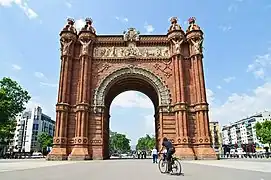Josep Vilaseca i Casanovas
Josep Vilaseca i Casanovas (Catalan pronunciation: [ʒuˈzɛb ˌbiləˈsɛkə]; Barcelona, Spain 1848–1910) was a Spanish architect and artist who formed part of the Modernista movement.

The Arc de Triomf in Barcelona

Casa Pia Batlló
He studied architecture in Madrid and qualified in 1873. He travelled with Lluís Domènech i Montaner in Germany. By 1874 he was already teaching at the Escuela de Arquitectura de Barcelona, a post he held for the rest of his life.
Amongst his best-known works is the Arc de Triomf in Barcelona, built for the 1888 Universal Exposition. His work is a textbook case of the evolution of late neo-Classicism into Modernisme which took place in Catalan architecture towards the end of the 19th century.
Other notable works:
- Casa Vilaseca, Plaça Urquinaona, 1874. No longer exists.
- Institucions Provincials de Cultura, jointly with Lluís Domènech i Montaner, 1877.
- Casa Pia Batlló , in Rambla de Catalunya, 1901.
- Casa Comas i Argemí , in Avinguda de la República Argentina, 1909.
- Casa Cabot , in Carrer de Lloria, 8, 1906.
- Cases Batlló, on the corner of Carrer Mallorca and Passeig de Gràcia.
- Casa Bruno Quadros , in the Rambla.
This article is issued from Wikipedia. The text is licensed under Creative Commons - Attribution - Sharealike. Additional terms may apply for the media files.